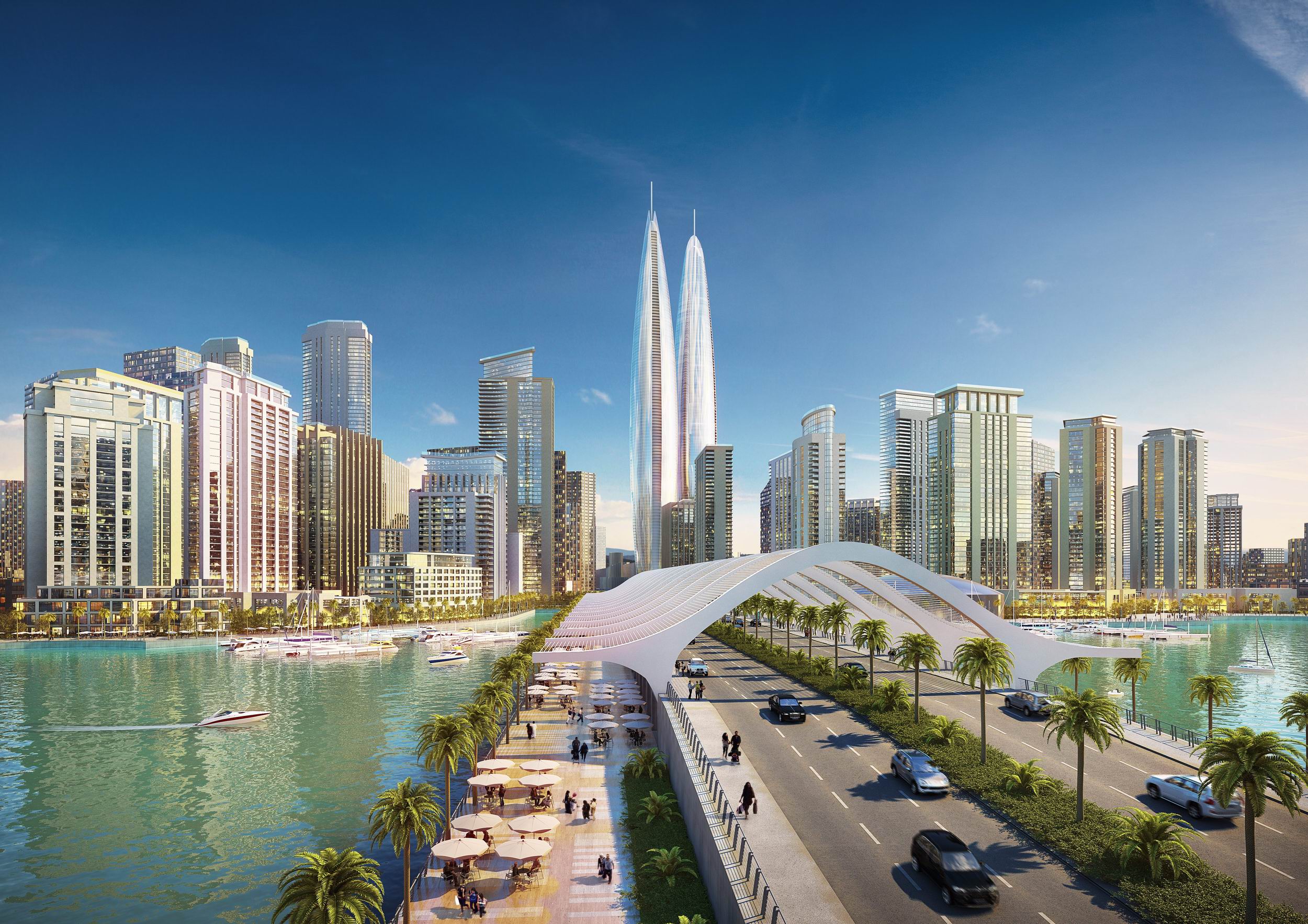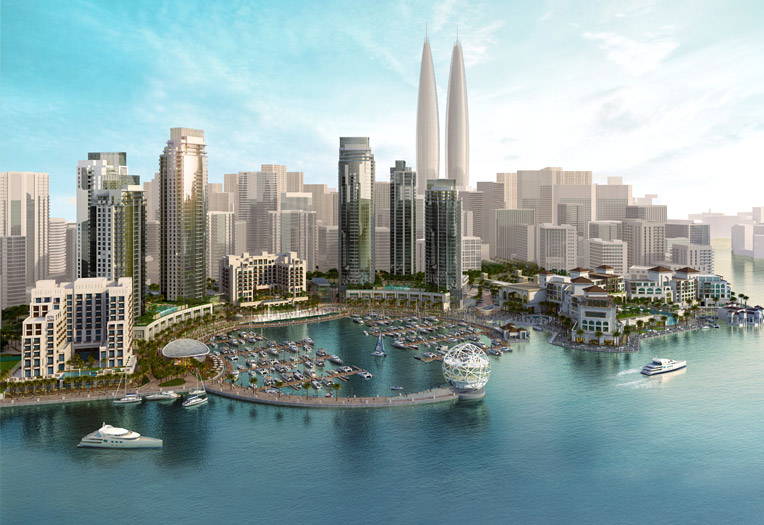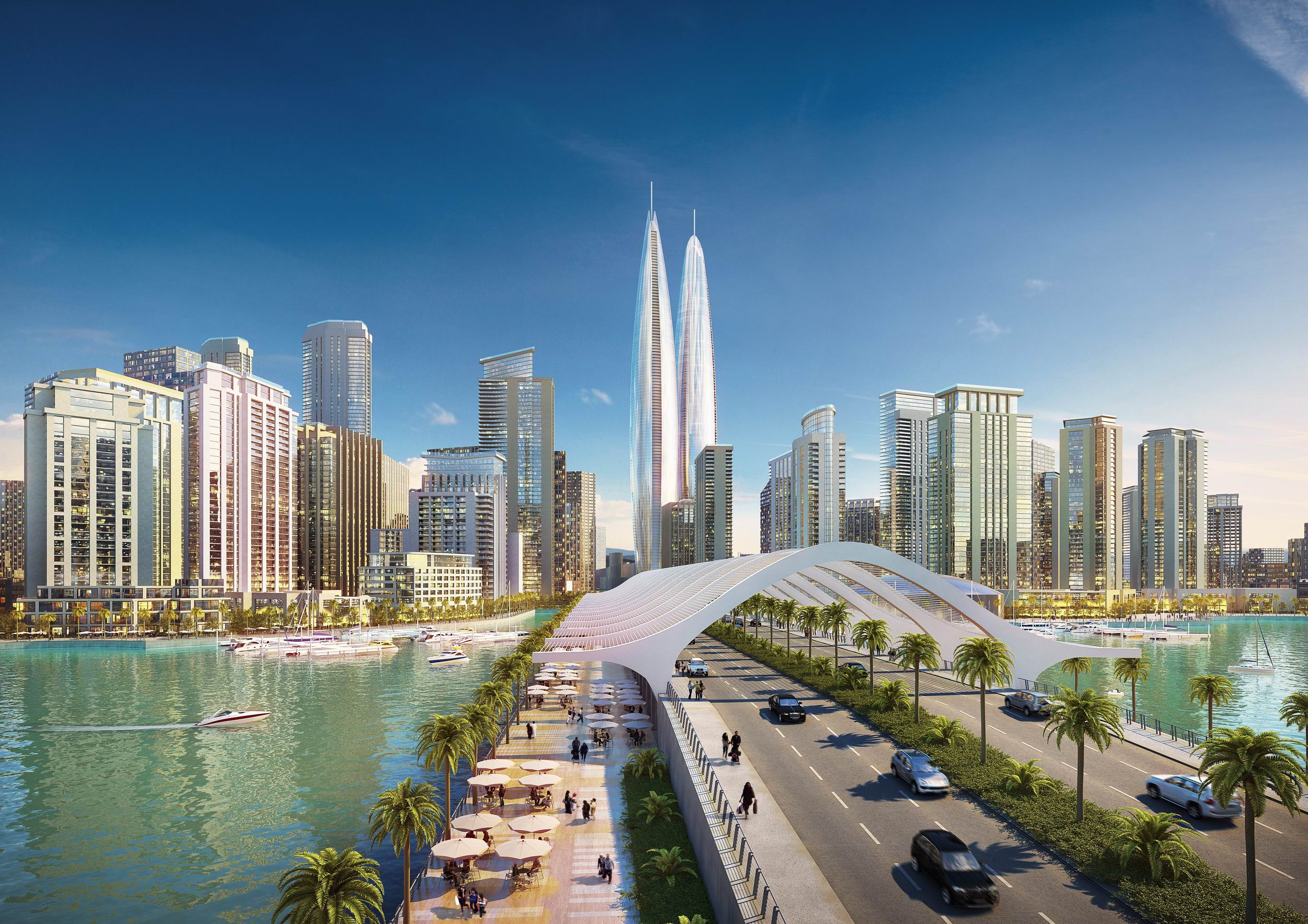Emaar Properties, known for its futuristic approach to buildings, has unveiled plans for a new project containing two towers that will top the charts in height, making them the world’s tallest towers once completed.
Dubai Creek Harbour will boast 39,000 homes and 22 hotels, making it three times the size of its downtown area, which contains the world’s tallest building, Burj Khalifa. Emaar Properties is partnering with Dubai Holding on this project.
Six towers, retail elements, and three hotels will round out Dubai Creek Residences, the first phase of the project, with the twin towers expected to be the centerpiece of the development. The six towers, which are 40 stories tall, will become waterfront properties, and contain one, two, and three bedroom apartments ranging from 880 to 2,154 sf. Dubai Creek Harbour as a whole will encompass 6 million sm (or 1,482 acres).
Starting November 1, apartments in two of the six towers will be available for sale on a first-come first-serve basis in the following locations: Dubai, Abu Dhabi, London, and Moscow.
Chairman of Emaar Properties, Mohamed Alabbar, told The National that the current market will be able to handle this magnitude of a project. “I think all the stakeholders in Dubai in this business learnt their lessons and have matured, the buyer, seller, bank, and regulator,” said Alabbar. “What is boils down to is supply and demand.”
Alabbar also commented to Dubai Holding that the vision of the project, “was to create a dynamic city of the future that integrates smart networks, while building on the cultural heritage of our city.”
Emaar Properties has not released information about the cost of the project, funding requirements, when ground will be broken, or the architect of the project.
For more information, visit www.emaar.com.
Related Stories
| Feb 15, 2011
Iconic TWA terminal may reopen as a boutique hotel
The Port Authority of New York and New Jersey hopes to squeeze a hotel with about 150 rooms in the space between the old TWA terminal and the new JetBlue building. The old TWA terminal would serve as an entry to the hotel and hotel lobby, which would also contain restaurants and shops.
| Feb 15, 2011
New Orleans' rebuilt public housing architecture gets mixed reviews
The architecture of New Orleans’ new public housing is awash with optimism about how urban-design will improve residents' lives—but the changes are based on the idealism of an earlier era that’s being erased and revised.
| Feb 15, 2011
LAUSD commissions innovative prefab prototypes for future building
The LA Unified School District, under the leadership of a new facilities director, reversed course regarding prototypes for its new schools and engaged architects to create compelling kit-of-parts schemes that are largely prefabricated.
| Feb 15, 2011
New 2030 Challenge to include carbon footprint of building materials and products
Architecture 2030 has just broadened the scope of its 2030 Challenge, issuing an additional challenge regarding the climate impact of building products. The 2030 Challenge for Products aims to reduce the embodied carbon (meaning the carbon emissions equivalent) of building products 50% by 2030.
| Feb 15, 2011
New Urbanist Andrés Duany: We need a LEED Brown rating
Andrés Duany advocates a "LEED Brown" rating that would give contractors credit for using traditional but low cost measures that are not easy to quantify or certify. He described these steps as "the original green," and "what we did when we didn't have money." Ostensibly, LEED Brown would be in addition to the current Silver, Gold and Platinum ratings.
| Feb 15, 2011
AIA on President Obama's proposed $1 billion investment in energy conservation
The President’s budget increases the value of investment in energy conservation in commercial buildings by roughly $1 billion, reports AIA 2011 President Clark Manus, FAIA. The significant increase from the current tax deduction of $1.80 per sq. ft. now on the books is an increase for which the AIA has been advocating in order to encourage energy conservation.
| Feb 14, 2011
Sustainable Roofing: A Whole-Building Approach
According to sustainability experts, the first step toward designing an energy-efficient roofing system is to see roof materials and systems as an integral component of the enclosure and the building as a whole. Earn 1.0 AIA/CES learning units by studying this article and successfully completing the online exam.
| Feb 11, 2011
Four Products That Stand Up to Hurricanes
What do a panelized wall system, a newly developed roof hatch, spray polyurethane foam, and a custom-made curtain wall have in common? They’ve been extensively researched and tested for their ability to take abuse from the likes of Hurricane Katrina.
















